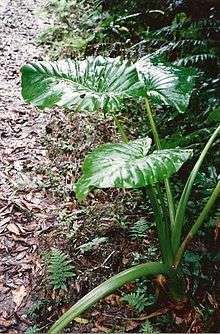Alocasia brisbanensis
| Alocasia brisbanensis | |
|---|---|
 | |
| Alocasia brisbanensis growing near the Wilson River, Australia | |
| Scientific classification | |
| Kingdom: | Plantae |
| (unranked): | Angiosperms |
| (unranked): | Monocots |
| Order: | Alismatales |
| Family: | Araceae |
| Subfamily: | Aroideae |
| Tribe: | Colocasieae |
| Genus: | Alocasia |
| Species: | A. brisbanensis |
| Binomial name | |
| Alocasia brisbanensis (F.M. Bailey) Domin | |
Alocasia brisbanensis is a species of plant in the family Araceae. Its common name is native lily or cunjevoi (the latter term also refers to a marine animal). It is native to rainforests of Eastern Australia. This plant has very large, spade shaped leaves on long, fleshy petioles. Alocasia may grow to a height of 1.5 metres. The summer flowers are a perfumed, greenish-cream colour that is similar to an arum lily. Red fruits follow the flowering.[1][2]
The plant is poisonous. Skin contact can lead to skin and eye irritation. Eating it causes immediate pain, burning sensation and swelling of the lips, tongue and mouth. Deaths have been reported.[3] The poisonous agent is insoluble oxalate. As first aid rinse lengthily, administer small amount of milk, do not induce vomiting.[4]
The plant, related to Taro, is edible when well cooked. The closely related and almost indistinguishable plant Alocasia macrorrhizos is cultivated as a food plant in some parts of Oceania.
-
Alocasia brisbanensis (cunjevoi) growing at Dorrigo National Park, Australia
References
- ↑ Wrigley, John W. & Murray Fagg, Australian Native Plants, 4th ed., Reed Books, Kew, Victoria, 1997, ISBN 0-7301-0493-1
- ↑ "Factsheet - Alocasia brisbanensis". keys.trin.org.au. Retrieved 2016-03-30.
- ↑ Queensland Government
- ↑ TOXINZ Database by University of Otago and the New Zealand National Poisons Centre
